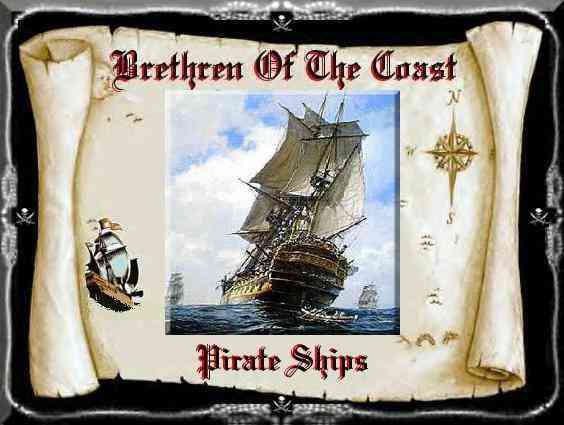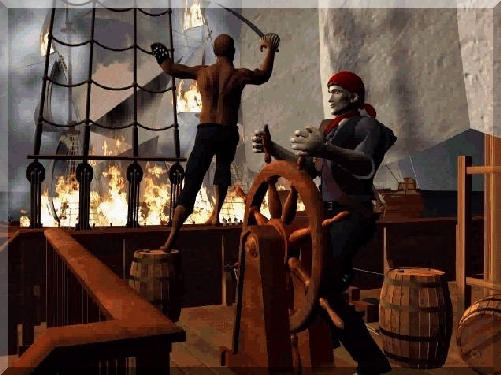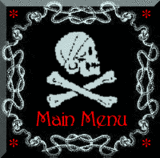

Pirates of old used many types of ships, anywhere from a small sloop to a large warship. But generally they gave preference to those with the greatest speed as it would do no good to spot a potential target only to have it out-sail you. Also pirates wanted a quick escape if needed. The pirates kept their ships in good order, careening them regularly to keep the hulls smooth and clear of seaweed and other marine life. This work was essential in order to maintain their speed advantage. Two of the pirates favorite types of ships were the sloop and the schooner. The speed and shallow draft of these ships enabled the pirates to hide in relative safety in shallower coastal waters where larger warships could not enter.

The single-masted sloop had a bowsprit almost as long as her hull making her perhaps one of the swiftest vessels of her day. If the wind was favorable, a square topsail could be hoisted to give her a top speed that could on occasion exceed eleven knots. The Sloop was a favourable ship for pirates and smugglers alike. This relatively small vessel could carry around 75 pirates and 14 cannons. The Sloop was often the ship of choice for hunting in the shallower channels and sounds. The Schooner which came into widespread use around the last half of the eighteenth century is a little of all of the best features in a pirate ship. Perhaps her greatest virtue lie in her shallow draft. She was favored by pirates of the North American coast and the Caribbean. Fully loaded she was still small enough to navigate the shoal waters and to hide in remote coves. The Schooner could also reach 11 knots in a good wind.

Another versatile ship the Brigantine was more of a captain's ship for a pirate. This 150 ton, 80 foot vessel could carry around 100 pirates mounting 10 cannons and a cargo space about twice as big as the sloop. She had two masts. Her main sail could be fitted with either square sails that were best in quartering wind, or fore-and-aft sails for sailing windward. This ship was the clear choice for battle or combat rather than the quick, hit and run type piracy tactics that were practiced with the sloops and schooners. Also keep in mind that pirates could not build a ship to order like the merchants and military did. They had to be opportunists and having looted a ship, the pirates would either burn the vessel, let it go on it's way, set it adrift, or take the ship over for their own use. Most pirate ships were no more then captured vessels taken as prizes and then altered to suit the pirates needs.

The large three-masted squarerigger type ships could be fitted with over twenty cannon plus many swivel guns and a crew of around two hundred men. She could make a formidable adversary and an excellent flagship for pirates despite her lack of agility. Many ships would probably have surrendered to her without a shot fired if they were not fast enough to out-sail her. Besides being greatly feared and comparable to a Navy Frigate, she had a reputation for seaworthiness on long voyages and a cargo space over twice as large as that of the sloop. One of the most impressive aspects of some of the early eighteenth century pirates is the enormous voyages which they made in search of riches. They sailed the North American coast from Newfoundland to the Caribbean. They crossed the Atlantic to the Guinea coast of Africa. And they rounded the Cape of Good Hope to Madagascar in order to plunder the ships in the Indian Ocean.

The Barbary corsairs of the Mediterranean used oar powered galleys rowed by slaves. These were long rather slender craft which were renowned for their speed, and sailing ships traveling in the calm winds of the Mediterranean were at their mercy. Their oars made them very quick, enabling them to maneuver quite easily and to come alongside an intended victim. When the winds picked up the corsairs hoisted a large lateen sail on a single mast amidships. The galleys were armed with one or more big guns at the bow, and several swivel guns were also mounted along the side rails. But their main weapon was in their fighting crews who numbered around one hundred men. These men were used to quickly swarm aboard a ship and sweep aside all opposition.

CAPTAIN
Today there are many different misconceptions and myths about buccaneers throughout history. A common misconception made by many people is in the role and authority of the pirate captain. Unlike naval captain's who were appointed by their respective governments and who's authority was supreme at all times. Most pirate captain's were democratically elected by the ships crew and could be replaced at any time by a majority vote of the crewmen. For example some captains were voted out and removed for not being as aggressive in the pursuit of prizes as the crew would have liked. And others were abandoned by their crews for being alittle to bloodthirsty and brutal. They were expected to be bold and decisive in battle. And also have skill in navigation and seamanship. Above all they had to have the force of personality necessary to hold together such an unruly bunch of seamen.
This left the captain of most pirate ships in a rather precarious position and some were in truth little more then a figurehead. Generally speaking, he was someone the crew would follow if he treated them well and was a fairly successful pirate captain..... but, could be replaced if enough of the men lost confidence in him and felt he wasn't performing his duties as well as he should. However, despite all this the captain was frequently looked upon with respect as a knowledgable leader of men. And the pirate crews historically appeared to have followed his judgement in most matters. There are surprisingly few detailed descriptions of what the pirate captains looked like, and those we do have are rarely flattering. Most seem to have adopted the clothes of naval officers or merchant sea captains, which in this period followed the style of English gentlemen.
QUARTERMASTER
During the Golden Age of Piracy, most British and Anglo-American pirates delegated unusual amounts of authority to the Quartermaster who became almost the Captain's equal. The Captain retained unlimited authority during battle, but otherwise he was subject to the Quartermaster in many routine matters. The Quartermaster was elected by the crew to represent their interests and he received an extra share of the booty when it was divided. Above all, he protected the Seaman against each other by maintaining order, settling quarrels, and distributing food and other essentials.
Serious crimes were tried by a jury of the crew, but the Quartermaster could punish minor offenses. Only he could flog a seaman after a vote from the Crew. The Quartermaster usually kept the records and account books for the ship. He also took part in all battles and often led the attacks by the boarding parties. If the pirates were successful, he decided what plunder to take. If the pirates decide to keep a captured ship, the Quartermaster often took over as the Captain of that ship.
SAILING MASTER
This was the officer who was in charge of navigation and the sailing of the ship. He directed the course and looked after the maps and instruments necessary for navigation. Since the charts of the era were often inaccurate or nonexistent, his job was a difficult one. Many Sailing Masters had to be forced into pirate service.
BOATSWAIN
The Boatswain supervised the maintenance of the vessel and its supply stores. He was responsible for inspecting the ship and it's sails and rigging each morning, and reporting their state to the captain. The Boatswain was also in charge of all deck activities, including weighing and dropping anchor, and the handling of the sails.
CARPENTER
The Carpenter was responsible for the maintenance and repair of the wooden hull, masts and yards. He worked under the direction of the ship's Master and Boatswain. The Carpenter checked the hull regularly, placing oakum between the seems of the planks and wooden plugs on leaks to keep the vessel tight. He was highly skilled in his work which he learned through apprenticeship. Often he would have an assistant whom he in turn trained as a carpenter.
MASTER GUNNER
The Master Gunner was responsible for the ship's guns and ammunition. This included sifting the powder to keep it dry and prevent it from separating, insuring the cannon balls were kept free of rust, and all weapons were kept in good repair. A knowledgeable Gunner was essential to the crew's safety and effective use of their weapons.
MATE
On a large ship there was usually more than one Mate aboard. The Mate served as apprentice to the Ship's Master, Boatswain, Carpenter and Gunner. He took care of the fitting out of the vessel, and examined whether it was sufficiently provided with ropes, pulleys, sails, and all the other rigging that was necessary for the voyage. The Mate took care of hoisting the anchor, and during a voyage he checked the tackle once a day. If he observed anything amiss, he would report it to the ship's Master. Arriving at a port, the mate caused the cables and anchors to be repaired, and took care of the management of the sails, yards and mooring of the ship.
SAILOR
The common sailor, which was the backbone of the ship, needed to know the rigging and the sails. As well as how to steer the ship and applying it to the purposes of navigation. He needed to know how to read the skies, weather, winds and most importantly the moods of his commanders. Other jobs on the ships were surgeon (for large vessels), cooks and cabin boys. There were many jobs divided up amongst the officers, sometimes one man would perform two functions. Mates who served apprenticeships were expected to fill in or take over positions when sickness or death created an opportunity.

Ship Classes
BARK (BARQUE)
Before the 1700's the name was applied to any small vessel. Later it applied to a small ship having three masts. The first two being square-rigged, and the third ( aft mast ) being fore-and-aft rigged. Fast ship with shallow draft. Favorite of Caribbean pirates. Crew around max. of 90.
BRIGANTINE
The brigantine was originally a small ship carrying both sails and oars. It was a favorite of Mediterranean pirates from whence it got its name. Italian word brigantino meant...brigand's ship. Later the ship referred to a two-masted sailing ship with its fore-mast square-rigged and fore-and-aft sails on its main mast. The word eventually was split into brig and brigantines. Each word meaning a different class of ship. The brig was reserved for a re-rigged ship with much greater sailing power.
CARAVEL
A small ship meant for trading. Originally lateen-rigged they later developed into square-masted ships and were used by the Spanish and Portuguese for exploration. Around 80 feet long.
CARRACK
Before the advent of the galleon, carracks were the largest ships. They often reached 1,200 tons. They were used for trading voyages to India, China, and the Americas by the Spanish and Portuguese. They were 3 masted with square sails on the fore and main masts and lateen-rigged on the mizzen. They had very high fore and aft-castles. She carried an immense amount of power and thus was able to easily fend off pirates. Only through surprise could one hope to take one of these towering giants.
DHOW
Dhows were meant to be trading ships, having a single mast which was lateen-rigged. They were from 150 to 200-ton ships. Arab pirates arming her with cannon would use these ships.
FRIGATE
The name frigate came from the Italian word fregata which may have come from the latin word fabricata, meaning something built. The Venetians called a frigate a small oared boat around 35 feet in length and around 7 feet wide. The English adopted the word for a larger ship which may have carried oars. Around 1700, the English limited the word to mean a class of warship which was only second in size to the Ship-of-the-Line (battleship). Frigates were three-masted with a raised forecastle and quarterdeck. They had anywhere from 24 to 38 guns on her deck. They were faster than the ship-of-the-lines and were used for escort purposes. They were sometimes used to hunt pirates. Only a few pirates were ever in command of a frigate as most pirates would flee from a frigate.
FUSTE (FUSTA)
A favorite of Barbary Corsairs, it was a small ship with both sail and oars. It was fast, long and had a low profile.
GALIOT (GALLIOT)
The Galiot was long, and sleek with a flush deck. She carried anywhere from 2 to 10 small cannon. She was powered by oar and carried from 50 to 130 men. The Galiot was used by Barbary and Corsair pirates.
GALLEON
Galleons were large ships meant for transporting cargo. Galleons were sluggish behemoths, not able to sail into or near the wind. The Spanish treasure fleets were made of these ships. Although they were sluggish, they weren't the easy target you would expect for they could carry heavy cannon which made a direct assault upon them difficult. She had two to three decks. Most had three masts, forward masts being square-rigged, lateen-sails on the mizzenmast, and a small square sail on her high-rising bowsprit. Some galleons sported 4 masts but these were an exception to the rule.
GALLEY
Galleys have an extremely long history, dating back to ancient times. They were used until the Russo-Swedish war of 1809. They had one deck and were mainly powered by oars. They were costly to maintain and fell into disuse. However they were still being used by the Barbary corsairs in the Mediterranean. As they were meant to carry soldiers they were used in a few large-scale raids. There was a version of the galley used in the Atlantic by the English. They had a flush deck and were propelled by both oar and sail. They were rigged like frigates. Captain Kidd made his name in one of these, the "Adventure Galley".
JUNK
The word junk derives from the Portugues junco, which in turn came from the Javanese word djong, which means ship. The ship has a flat-bottom with no keel, flat bow, and a high stern. A junk's width is about a third of its length and she has a rudder which can be lowered or raised providing excellent steering capabilities. A junk has two or three masts with square sails, made from bamboo, rattan or grass. Contrary to belief, the junk is capable of operating in any seas as she is a very sea-worthy vessel.
LONGBOAT
Much like a rowboat except they were very long. They were carried on ships and used for coming and going to the ship. They were normally rowed but often had a removable mast and sail.
MAN-O-WAR (SHIP-OF-THE-LINE)
These ships were the "heavy-guns" of the fleet. They resembled galleons in design, but sported heavy fire-power with an average of 65 guns. It was not uncommon to have over 100 guns. They were around 1,000 tons and had 3 masts, which were square-rigged, except for a lateen sail on her aft-mast. Only the three major sea-powers of the time (Spain, England, and France) had an extensive use of these ships.
MERCHANT (PINK)
There are two classifications of Pink. The first was a small, flat-bottomed ship with a narrow stern. This ship was derived from the Italian pinco. It was used primarily in the Mediterranean as a cargo ship. In the Atlantic the word pink was used to describe any small ship with a narrow stern, having derived from the Dutch word pincke. They were generally square-rigged and used as merchantmen and warships.
SCHOONER
The Schooner has a narrow hull, two masts and is less than 100 tons. She is generally rigged with two large sails suspended from spars reaching from the top of the mast toward the stern. Other sails sometimes were added, including a large headsail attached to the bowsprit. She had a shallow draft which allowed her to remain in shallow coves waiting for her prey. The Schooner is very fast and large enough to carry a plentiful crew. It was a favorite among both pirates and smugglers.
SHEBEC (XEBEC)
The Shebec was favoured among Barbary pirates for she was fast, stable and large. They could reach 200 tons and carried from 4 to 24 cannon. In addition she carried from 60 to 200 crewmen. The Shebec had a pronounced overhanging bow and stern, and three masts which were generally lateen-rigged. In addition to sails she was rowed.
SLOOP
The Sloop was fast, agile, and had a shallow draft. Her size could be as large as 100 tons. She was generally rigged with a large mainsail which was attached to a spar above, to the mast on its foremost edge, and to a long boom below. She could sport additional sails both square and lateen-rigged. She was used mainly in the Caribbean and Atlantic. Today's sailing Yacht is essentially a sloop.
TARTAN
The name Tartan applies to an Arabic ship which was fast, manueverable, and narrow. She sported one mast with a lateen mainsail and a small foresail on her bowsprit. In addition she carried around 30 oars, 15 per side. Sometimes a small mizzen mast was added with a lateen sail. She was used in the Mediterranean by the Barbary and Corsair pirates

Page best viewed with a 1024x768 screen resolution.
Copyright © 2000-2005 KAL/BrethrenCoast. All Rights Reserved.